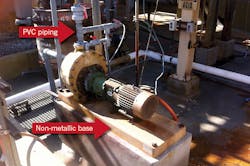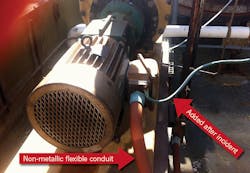The Case of the Improperly Terminated Motor
For most electrical professionals working in an industrial or manufacturing setting, motor replacement is considered routine maintenance work. This case, which involved a 25-hp, 460V 3-phase motor that had been in service for several years but needed to be replaced due to failed bearings, appeared to be no different than other motors the in-house electrical staff had worked on in this particular industrial facility. But after replacing the motor, the pump still wasn’t operating properly — it continued to trip repeatedly on overcurrent upon startup. As a result, in-house maintenance mechanics were called in to troubleshoot the situation and get to the root of the problem. Note: At this facility, certain employees perform electrical work (wiring, electrical hook-up of motors, transformers, etc.) and others handle mechanical work (installing and aligning motors, piping, welding, etc.)
The scene
One electrician simply isolated and disconnected the failed motor from the electrical supply so that the maintenance mechanics could remove it, install a replacement motor, and correctly align it to the pump. Another electrician reconnected it. Both men were in-house electricians with several years of experience that took their work very seriously, were considered competent, and always maintained a clear focus on safety.
Because the pump was operating in hydrochloric acid service, the pump and motor base, the piping, and all surrounding support were made from non-metallic materials to prevent corrosion. The site, of course, required grounding conductors to all motors, the ground conductor was run with the phase conductors, and was connected to the grounding connection in the motor terminal box, as required by company specifications and applicable codes and standards. At the time, the site did not require an additional external equipment grounding conductor, which would have been run external to the conduit/tray/channel that contained the phase supply conductors and grounding conductors, for motors below 200 hp. The motor frame had no external connection to ground either through a separate conductor, piping, or the motor frame. Note: Company policy now requires an additional external grounding conductor to be connected to the motor frame in cases where the motor/pump base is made of non-metallic materials.
The accident
While troubleshooting the small acid pump, the maintenance mechanic started the motor while leaving his hand on the pump housing, which was connected to the motor frame. Immediately suffering a serious electric shock, the victim received current flow from one hand through his upper body to his feet or legs (it was not clear which). Although he reported experiencing severe pain and discomfort from the shock, the victim exhibited no external signs of injury. However, he was still taken to an on-site medical facility, where he was evaluated and kept for the rest of the shift for observation. Fortunately, no injury or subsequent complications resulted from this accident. In retrospect, it was determined that the level of current was likely limited because the victim was wearing rubber boots (not for shock protection but for protection from injury due to the chemical burn risk in the area).
Following the incident, many questions remained. At the top of everyone’s mind was what had caused an electrician with more than 20 years of experience — considered a responsible, proficient, and “qualified person” — to obviously make an incorrect motor connection?
Investigation and analysis
The author, who served as the Instrument & Electrical (I&E) superintendent in the maintenance department was called in to investigate from a reliability angle as well as a safety standpoint. He was not only the leader of electrical safety initiatives at the facility (responsible for establishing electrical safety policies and procedures), but he also oversaw the development and implementation of such requirements in safety policies and procedures. The initial investigation uncovered several facts.
The motor feeder had three color-coded phase conductors: black, red and blue, and one green insulated equipment grounding conductor. A grounding lug was provided inside the motor terminal box. The motor had been connected incorrectly with the blue conductor connected to the grounding lug and the green conductor connected to one of the motor leads. This, combined with the fact that the unit was basically insulated from ground, caused the motor to single phase. Why didn’t someone notice this problem prior to the accident? Similar symptoms would have been present if the pump had been plugged or had restricted flow — and since the motor had just been changed — the staff felt like the problem was with the pump.
Although the installation had been in service for some time and the feeder conductor colors had faded somewhat, they were still clearly identifiable. During the follow-up investigation, an interesting development was uncovered. After being called to the accident site for additional clarification on what had happened that day, the electrician that reconnected the motor stated that the motor connections were correct — with the green colored conductor connected to the grounding lug. This shed light on the underlying problem, given the fact that the blue conductor was connected to the grounding lug. After this was pointed out to him, the victim admitted he was color blind and had difficulty identifying phase conductors by color alone. Instead, he relied on numbers, letters, or some other identification method (coworkers) for clarification.
Lessons learned
In corrosive environments, it’s next to impossible to find materials that are resistant to deterioration; therefore, non-metallic materials are typically used. Due to this fact, an additional external grounding conductor should be provided.
After the accident, electrical specifications were reviewed to be sure all similar existing and future installations included an external grounding conductor in addition to the one connected to the motor frame inside the motor terminal box. Adjustments were made and communicated to other plant sites within the company. Special emphasis meetings were also held with electrical and mechanical craftsmen to ensure the technical aspects of the incident were well understood. Lockout/tagout procedures include verification of proper voltage and current on all phase conductors once the motor is put back in service. The details of this incident, and proper procedures when non-conductive materials are used, are included in the company’s electrical safety training. The facility now also requires a color identification test as part of physical exams both for new hires and for routine, periodic exams of existing employees.
Although this incident wasn’t complicated and no legal action was taken, it did have a serious potential for injury or death. This case demonstrates how important it is for a company to create an environment in which employees feel comfortable discussing personal issues that pertain to their ability to do their jobs efficiently and safely. Individuals who possess limitations that could affect their status as a “qualified” worker (see Quantifying Qualified Persons) have a responsibility to discuss them with the appropriate people within the organization. Similarly, those in management positions who evaluate qualifications and assign jobs also have the same responsibility for proper consideration of such issues.
Pace, P.E., is a senior member of IEEE and a principal electrical engineer with Olin Corp., McIntosh, Ala. He can be reached at [email protected].
SIDEBAR: Quantifying “Qualified” Persons
Factors that determine whether or not a person is “qualified” include education, experience, training, and knowledge. The definition of a qualified person is one who has skills and knowledge related to the construction and operation of the electrical equipment and installations and has received safety training to recognize and avoid the hazards involved.
Other factors also affect whether or not a person can be considered “qualified” in the traditional way of thinking, including physical limitations, emotional issues, medical issues, and personal issues. Because employees or potential employees are often reluctant to discuss personal issues, the possibility (as in this case) could exist for an otherwise qualified person to actually be unqualified to do the work. Therefore, it’s important to assess individuals for various factors that could affect their status as a qualified person.
Sources: NFPA 70E and the National Electrical Code


